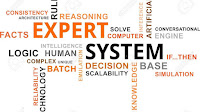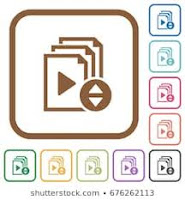A. DISTANCE LEARNING
Distance education has become the popular to describe learning via telecommunication. In this chapter the term communications embraces a wide variety of media configuration, including radio, telephone and television (broadcast, cable, and satellite). What they all have in common is implied in the Greek root word tele which means “at a distance“ or “a far of” that is they are system for communicating over or distance.
1. Elementary Education
At the elementary school, teachers tend to use pre-recorded video cassettes more often than live broadcast television programs. Still, several broadcast series are frequently used: at the elementary level, Sesame Street and Barney; at the intermediate, reading, rainbow, big comfy, Arthur, and zoom. These programs are used mainly as enrichment rather than as the core of instruction. Teachers who use educational televisions programming tend to used more than one program usually two or three but not a whole series ( Children’s Television Workshop 1990)
2. Secondary Education
At the secondary school, television is used mainly to expand the curricular offering of specific high school. Rural school are thus able to offer a full core curriculum. In advanced or specialized subject foe which there are not enough students in one school to justify hiring a teacher schools administration frequently use televisions to connect several school, thus creating a large enough “class” to be affordable.
3. Postsecondary Education
At the postsecondary education, telecommunication systems are used extensively for both on campus education. Hundreds and community colleges , technical school, colleges, and universities in Nort America use telecommunication as part of their regular instructional programs. The purpose generally is to expand the number of students who can be reached by one instructor in a given source.
B. INSTRUCTIONAL COMMUNICATION FUNCTIONS
Regardless of the technology used, from lived teacher to computer conferencing an instructional telecommunications system must perform certain function to be effective.
C. BROADCAST RADIO
When we listen to radio, we hear electronic signal that are broadcast or transmitted through the air over regular AM and FM Radio frequencies. Broadcast radio can be adapted to educational use. Although such radio is basically a format for one way lectures or dramatic presentations, some degree of interactivity can be added by using printed materials to accompany the programs and requiring listeners to send responses back to originator. Some programs provide a telephone number for the student to contact the instructor.
Advantages
• Cost . Radio is a less expensive broadcast medium than is television. It is still used in developing countries and in other localities where there are geographic or economic constrains on the technologies they can employ.
• Range. Radio programs can reach and larger geographically dispersed population with single message.
• Imagination stimulator. Because radio is an audio only medium, listeners are free to use their imaginations to create the image.
• Flexibility. The audio medium is extremely flexible and can have a powerful, dramatic effect, particularly, for conveying music, discussion, and story telling.
Limitations
• Operating expense. It is difficult to justify the expense of operating broadcast facilities when pre-recorded materials are readily available.
• Schedule. Broadcast radio is being displaced by pre-recorder material. Instructors and student resist using media that must be according to a rigid schedule.
D. AUDIO CONFERENCE
1. Audio conference
The audio conference is an extension of a simple telephone call. Advances in telephone technology phone now allow individuals or groups of people at two or more locations to hear and be heard cleary and easily.
Advantages
• Cost effective. The audio teleconference is often seen as a cost-effective way to hold a meeting or training session without the expense of time and money involved in travel. School invite an expert “into the classroom” to engage in a dialogue with students .
• Easy to use. It is the most easily accessible form of telecommunication because is uses standard telephone service. Commercial phone companies have made is easy to set up audio teleconference from any touch tone phone.
• Interactive. All participant get the same interactivity. They can talk to the instructor a guest speaker or the other participant.
Limitations
• Lack of visual information. The lack of visual dimensional proses limitations. This can be offset by arranging to have material in the sites in advance.
• Poor audio. To have acceptable audio quality, each receiving site needs to have special microphone amplifier advice.
• Intimidating. Lack of experience with this type of communication technology may make some learners less willing to participate.
2. Audio Graphic Teleconference
An audio graphic teleconference adds still-pictures transmission to an audio teleconference. Several different devices can be used to send pictures graphic over the same telephone lines as the voice signal: slow-scan (single scan)analog video, facsimile(fax) paper copies, or an electronic graphic tablet. The common denominator in these devices is a method of covering the image digital form for transmission.
Advantages
• Visual. The big advantage of audio graphic systems over other audio formats is the addition of the visual element.
• Cost. Unless full-motion images are needed, audio graphics can be provide and audio visual experience at a fraction of the cost of television.
Limitations
• Availability. Audio graphic technologies are not readily available.
• Time factor. It can take nearly a full minute to transmit a still image via fax or slow scan technologies.
E. TELEVISION IN DISTANCE LEARNING
1. One-Way Video, One-Way Audio
Of all the uses of television in education, the viewing of pre-recorded video cassettes and videodiscs is the most common. Here we will consider the next most common form of television use live viewing of programs without direct feedback to the presenter.
2. Two-way video, Two-way Audio
Fully interactive television with two way communication of both audio and video, or two way television is achieved by equipping both the sending and receiving sites with camera and microphone and interconnecting them by some means capable of two way transmission. This may be fiber optics, cable, microwave, satellite, or a combination of these. A school or other organization may operate its own video teleconference facilities or lease them as needed for specific occasions.
3. Online Technologies
Online technologies (those that rely on computer based systems) have opened up a new array of distance learning opportunities. Where once students had to drive a short distance to attend a class conveyed by a video or audio connection, computer-based system let them remain in learning activities. Software programs, cameras, and array of resources can give students distance learning. Students can attend class at designated time, can participate, in an audio, video, or text-based chat, can post to bulletin board discussion and can access information. It is possible for a mixture of distance learning technologies to take advantage of the contributions of each type of technology.
F. DISTANCE LEARNING ISSUES
1. Role of Students
Student need to know their roles in a distance learning experience. Early attempt at this type of instruction tended to involved a” talking head” with student passivelly sitting in the distance sites, often not attending to the “head”. More recently, with technological advances, interaction among students and between sites is feasible. Student can be become more engaged in their learning. It remains the teacher responsibility, however to guide students on how on interact appropriately.
2. Role of teacher
When we begin to talk about the teacher in the distance learning classroom, it is necessary to think about the setting in a new light. The classroom is now a series of “rooms” connected electrically. The origination classroom is the one where the teacher is present. Distance sites or remote classrooms are the location connected by the telecommunication systems. At the distance sites, they may be only one or two students or there may be a full class. Additionally there may be a distance site facilitator, an adult whose responsibility it is to work with the teacher. The facilitator may be another teacher or a classroom aide. The duties of a facilitator vary depending on the course content and the origination classroom teacher’s needs.
3. Visualizing instruction
With technologies for distance learning that rely on television, the teacher may need to change existing teaching materials. The document camera is a valuable teaching tool for showing student visuals and for demonstrating specifics task. Although teacher may be able to use classroom materials such as overhead transfarencies, these materials tend to be in a format not easily visible on the monitors. Television has a horizontal or landscape orientations, which mean that materials prepare in a vertical orientation will not be as easily seen. It may be necessary to redo materials. One suggestion is to have all classroom materials prepared so they can be used in either a regular or a television classroom setting.
4. Accessing resource at a distance
One element often overlooked in a distance learning situation is the access students have to resource materials. The amount of available information resources is expanding at an exponential rate.
Advantages
• Cost efficiency. All forms of broadcasting share the attribute of teaching geographically dispersed audiences in a cost-efficiency way.
• Audio visual capacity. All television system allow a transmission of motion images and sound image distance.
• Two way possibilities. When learner can communicate with the instructor and other student via telephone or two way video, you can approximate a live classroom interactions.
• Online possibilities. When available, online technologies can provide access to resource an two interaction that might not be otherwise possible.
Limitations
• Cost for two way . Adding or capacity for two communication may require costly hardware installation, including a bridge if multiple sites are connected at once. If using telephone, there may be toll charge for the call.
• Facilities for two way. The special setups needed for two way video require that a classroom be dedicated to this used, thus making it difficult to use the rooms for other purpose.
• Technical problem. Technical problem may interrupt the instructions and may create confusion and frustration for the instructor and students .
• Isolation. learners to participate in broadcasting lessons without talkback capacibilities can feel like second class citizen having little rapport with the rest of the group.
• Inexperience. Instructors may not feel comfortable teaching in this type of setting.
• Reluctance. Students may be reluctance to assume greater responsibility for their own learning.
• Connectivity. Students may have difficulty making certain types of online connections due to their type of access to the internet.
Source : Heinich, Molenda, Russell, Smaldino et. 2002. Instructural Media and Technologies for Learning volume 7. California: The University of California.











































